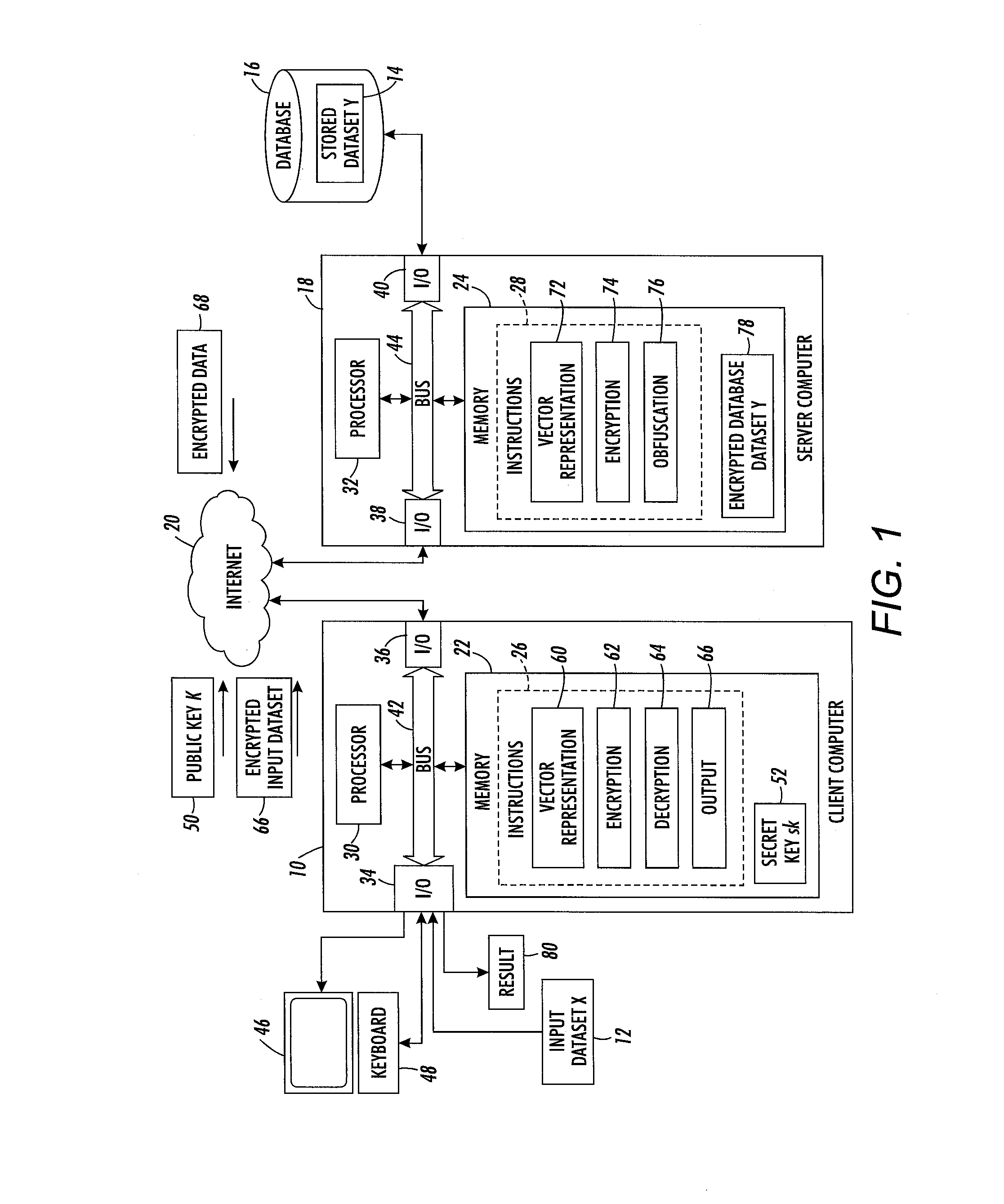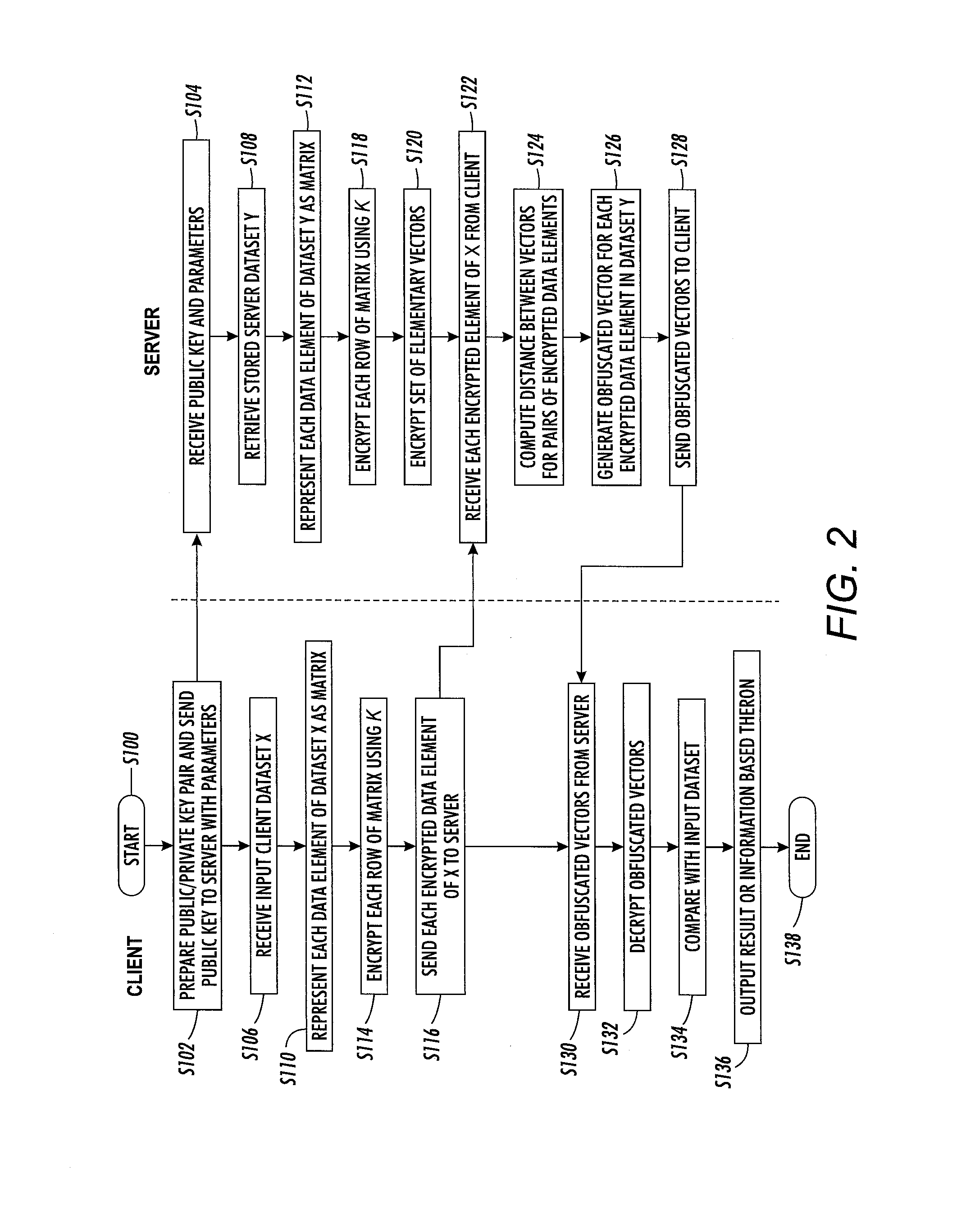Compact fuzzy private matching using a fully-homomorphic encryption scheme
a technology of fuzzy private matching and fully homomorphic encryption, applied in the field of data matching, can solve problems such as communication complexity, two-out-of-three protocol proposed by freedman 2004 is not secure in that the client is able, and some recognition errors
- Summary
- Abstract
- Description
- Claims
- Application Information
AI Technical Summary
Benefits of technology
Problems solved by technology
Method used
Image
Examples
case 1
):
[0098]
∃i∈[1 . . . m],Xi≈tYj∃i∈[1 . . . m],ΔH(Xi,Yj)∈[0 . . . (T−t)]
∃i∈[1 . . . m],{Πw=0T−t(ΔH(Xi,Yj)−w)}K={0}K
{Πi−1mΠw=0T−t(ΔH(Xi,Yj)−w)}K={0}K
{Πi−1mΠw=0T−t(ΔH(Xi,Yj)−w)·r}K+{Yj}K={Yj}K
[0099]The client then receives the obfuscated vector {Yj}K, decrypts it, and adds the result to the output as it is t-fuzzy with one of the client's word vectors.
case 2
):
[0100]The client receives the obfuscated vector: {Πi=1m Πw=0T−t (ΔH(Xi,Yj)−w)·rnd}K+{Yj}K, where rnd is a random vector formed by multiplying the random vectors r. As the double product is not the null vector, the client decrypts what appears to be a large random vector, from which Yj cannot be decrypted. The probability that a random rnd will produce a correct t-fuzzy element in AT is negligible. Therefore, the probability of a false positive is negligible. This vector is therefore not added to the output 80.
[0101]The client can do a simple check by comparing the Hamming distance on the decrypted obfuscated vector with each word of the client dataset. For example, if the input dataset corresponds to ‘cab’ and one of the decrypted vectors is ‘car’ a t-fuzzy match is found when t=1. The client could use a different value of t than used on the server side, although in the exemplary embodiment, the same value is used.
[0102]At S136, the client device outputs the result of the fuzzy ma...
example
[0131]A version of the CFPM-FHE protocol was implemented between a client and a server in a Linux environment. Client and server instructions are written in C++ and are deployed on two different machines having the same characteristics shown in TABLE 4.
TABLE 4Server and Client characteristicsCharacteristicValueCPUIntel(R) Xeon(R) CPU E3-1230 V2 @ 3.30 GHzRAM32 Gb of memoryOSCentOS release 6.5 (Final)Compilerg++ gcc version 4.4.7 20120313(Red Hat 4.4.7-4) (GCC)
[0132]The client's and the server's sets are stored in files, the communication is done using raw sockets, and the FHE library used is HELib (Shai Halevi, et al., “Helib” GPL source code published on GitHub https: / / github.com / shaih / HElib (2013). No optimization was done regarding the algorithms in this example or regarding the C++ core (use of multi-threaded elements, . . . ). The Helib scheme employs BGV, providing some optimizations to make homomorphic evaluation run faster, focusing mostly on effective use of the Smart-Verca...
PUM
 Login to View More
Login to View More Abstract
Description
Claims
Application Information
 Login to View More
Login to View More - R&D
- Intellectual Property
- Life Sciences
- Materials
- Tech Scout
- Unparalleled Data Quality
- Higher Quality Content
- 60% Fewer Hallucinations
Browse by: Latest US Patents, China's latest patents, Technical Efficacy Thesaurus, Application Domain, Technology Topic, Popular Technical Reports.
© 2025 PatSnap. All rights reserved.Legal|Privacy policy|Modern Slavery Act Transparency Statement|Sitemap|About US| Contact US: help@patsnap.com



